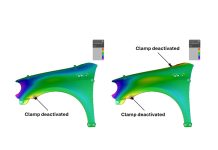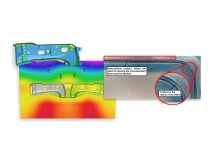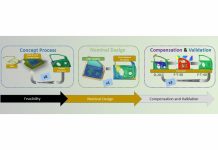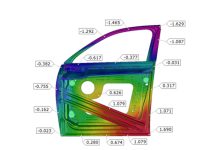
Hello community! In today’s blog post we go “behind the scene” of AutoForm-ProcessDesignerforCATIA creation process with three AutoForm leading figures.
What inspired a company leader in CAE software to step into the “CAD” world and invest resources into creating a tool directly integrated in the CATIA environment? And more importantly, what innovative approach is brought to the market with ProcessDesignerforCATIA and what can the users accomplish during the die layout design process by using its functionalities?
We’ll try to answer these questions and also explore other aspects of the AutoForm solution for Process Design in our talk with Dr. Waldemar Kubli – CEO, Matthias Pietsch – Software Development Manager and Dr. Markus Thomma – Corporate Marketing Director of AutoForm Engineering.
Essentially, the die layout design process consists of generating tool surfaces for each operation – drawing, trimming, flanging and forming; whereby tool surfaces must be created with CAD in order to be used later on for generating the tool paths for milling machines.
Different products (used either singularly or in combination) are available on the market to support users in accomplishing this task, but as Dr. Waldemar Kubli points out “the initial problem engineers used to face before AutoForm-ProcessDesignerforCATIA was launched arose due to the lack of dedicated functionalities. Despite the widespread use of different CAD systems in engineering, none of them is fully and efficiently suited to support all necessary phases of the sheet metal forming engineering process. This is particularly evident during the tool design phase when the die layout for the complete forming process must be defined and validated. AutoForm-ProcessDesignerforCATIA represents the strategic missing link that allows users around the world not only to complete designs for drawing dies but also for all secondary operations tools without leaving CATIA environment; and this is really something new”.

Figure 1 – Trim plan and relative trim lines definition
“This software allows users to create CAD-quality die faces in CATIA environment. The powerful features implemented in it are really easy-to-use, even for designers who are not very familiar with CATIA. Moreover, customers benefit from a company-wide standardization in process engineering and a significant reduction in time needed to create CAD-quality die faces. Transparency, data consistency and valuable engineering process support are only some of the additional advantages users will benefit from the use of ProcessDesignerforCATIA” Dr. Markus Thomma stated.
As already highlighted in earlier posts, the software has been successfully integrated in several well -known companies, like Volkswagen, who selected AutoForm-ProcessDesignerforCATIA as their software of choice.
The Four Principles that Make Die Face Creation a Breeze
So what new innovation was introduced with AutoForm-ProcessDesignerforCATIA?
As Matthias Pietsch, development manager who followed its creation explained, ‘the working “philosophy” brought by AutoForm-ProcessDesignerforCATIA stands on four-core principles that support users in the creation of the best in class tool surfaces. The systematic use of these principles allows an easy and quick creation of die faces. These four principles have quickly become a working standard that has been successfully applied even by experienced CAD engineers in both large organizations and major tool shops. AutoForm-ProcessDesignerforCATIA represents a new approach in tool designing allowing users to work with these best practices as a standard working model’.
‘The first of these principles was the creation of “Unique Features”. The unique features aimed at facilitating the daily work of process designers in creating “typical” tool surfaces or curves. Users can run computations of the flanges to accurately determine the trim line thanks to the combination of the finite element method with the CAD-based curve creation implemented in ProcessDesignerforCATIA; designers can generate draw beads with different sections (round, trapezoidal, etc..) and shape the endings at convenience directly on the binder and on the die surfaces at the same time for instance. Plus, users can compensate tools of all operations, and the compensation can be either carried out manually, in order to target surfaces, or automatically by importing the compensation field generated by our CAE module AutoForm-Compensatorplus; because of the perfect compatibility, data need not adjustments. But in all of this, the main point is that, as confirmed by the feedback we received from customers, even users not so familiar with CATIA native features are able to implement them and get the job done’ Matthias Pietsch says.

Figure 2 – Unique features example
The second principle is ‘the Reengineering and Surfacing Tools.’ continues Matthias Pietsch. ‘Rather than use so many different CATIA different commands for surface modeling, die layout designers find much more easier the use of the main commands we make available in ProcessDesignerforCATIA, because they provide exactly what is necessary to draw the typical surfaces. They exactly meet the needs of engineers. We are talking about a feature to define the Boundary surfaces of part continuation, a feature to connect and fill gaps, and feature to model the “Addendum” and finally create the die shapes. Combining these features, the user gets surface reengineered with free form surfacing with the most appropriate surface continuity. This is an important aspect because this means that these surfaces can be used as they are in down-stream modeling processes, such as over crowning or compensation for instance.’

Figure 3 – Re-engineering Surfacing Tools
‘Naturally the third principle became Standardization’ says Matthias Pietsch. ‘By using templates users can now share data consistently, company-wide in a standard manner. New process designs may be created by importing new geometries and adjusting the parameters so that consistency is kept and all new designs automatically fulfill company standards. Standardization helps improving both internal collaboration between different departments and external between OEMs and suppliers.’

Figure 4 – Standardization with Smart Templates
Because of particular complexity mostly connected to the final part shape, and because of the forming process peculiarities, the drawing die design probably represents the most time- and resource consuming process. The surfaces of the drawing die may undergo several modifications during the engineering and then during process design. Make the tool surfaces available for validation quickly without losing accuracy was crucial for the definition of the fourth principle: the Methodology.
As remarked by Matthias Pietsch ‘The software implements a sophisticated methodology which reduces the complexity of die face designing by dividing the entire design task into logical, independent and simpler design steps (sub-tasks). In each step, because referring to smaller segments, the user can focus just on few constraints. Plus, the creation of the part dependent geometry is carried out separately from the creation of the deep drawing related geometry. This clear and logical step-by-step approach is supported by the templates mentioned before, which amid the other benefits, works also as best practice instructions to guide the user through each task. The result is a clearly structured design which is easy to understand, modify or update’.

Figure 5 – Die Face Creation Methodology
To summarizing the benefits brought by AutoForm-ProcessDesignerforCATIA we can refer to what Dr. Markus Thomma, Corporate Marketing Director, stated: ‘Users of AutoForm-ProcessDesignerforCATIA will immediately recognize as the first benefit the surface modeling SPEED, which meets the demand for shorter product development cycles. With a speed factor of up to five already reached, this software allows the user to rapidly create high quality die faces considering both initial die face design as well as the modification of the existing once. Since all created die faces are parametric, further modifications can be carried out in seconds.
The second benefit is the shortened learning curve and the simplicity needed to achieve high SURFACE QUALITY where its creation in AutoForm-ProcessDesignerforCATIA is characterized by a massively reduced number of control elements needed and by the appropriate surface continuity. In contrast, high quality surfaces created with CATIA Native functionalities require more experienced users with a higher amount of parameters to be controlled, higher than the surfaces created with AutoForm-ProcessDesignerforCATIA. Our software achieves the same quality with, mathematically speaking, less complex surface descriptions. All generated surfaces fulfill A-Class surface requirements and can be directly used to determine tool path for CNC machining.
The positive feedback received on the performance of AutoForm-ProcessDesignerforCATIA is encouraging and motivates AutoForm to develop new innovative features, that will further lead to improved performance and important enhancements, such as 3D tool design and NC preparation’.














Waiting for process designer in NX, hope it will be fun to create die face in NX with help of AutoForm.
It’s wonderful to know about the ProcessDesignerforCATIA – A new tool design methodology in the CATIA environment.Thanks for sharing this useful information.